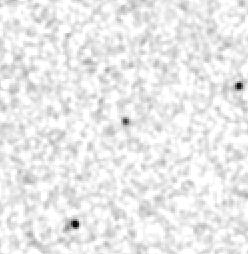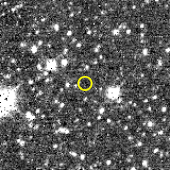Lysithea (moon)
 | |
| Discovery | |
|---|---|
| Discovered by | S. B. Nicholson |
| Discovery date | July 6, 1938[1] |
| Designations | |
Designation | Jupiter |
| Pronunciation | /laɪˈsɪθiə/[2][3] |
Named after | Λυσιθέα Lysithea |
| Adjectives | Lysithean /laɪˈsɪθiən/[4] |
| Orbital characteristics [5] | |
| 11717000 km | |
| Eccentricity | 0.112 |
| +259.2 days | |
| 329.1° | |
| Inclination | 28.30° |
| 5.5° | |
| 49.5° | |
| Satellite of | Jupiter |
| Group | Himalia group |
| Physical characteristics | |
Mean diameter | 42.2±0.7 km[6] |
| Mass | 6.3×1016 kg[citation needed] |
Mean density | 2.6 g/cm3 (assumed)[7] |
| 12.78±0.10 h[8] | |
| Albedo | 0.036±0.006[6] |
| Temperature | ~124 K |
| 18.2 | |
Lysithea /laɪˈsɪθiə/ is a prograde irregular satellite of Jupiter. It was discovered by Seth Barnes Nicholson in 1938 at Mount Wilson Observatory[1] and is named after the mythological Lysithea, daughter of Oceanus and one of Zeus' lovers.[9]
Lysithea did not receive its present name until 1975; before then, it was simply known as Jupiter X. It was sometimes called "Demeter"[10] from 1955 to 1975.
It belongs to the Himalia group, five moons orbiting between 11 and 13 Gm from Jupiter at an inclination of about 28.3°.[11] Its orbital elements are as of January 2000. They are continuously changing due to solar and planetary perturbations.

See also
References
- ^ a b Nicholson, S. B. (October 1938). "Two New Satellites of Jupiter". Publications of the Astronomical Society of the Pacific. 50: 292–293. Bibcode:1938PASP...50..292N. doi:10.1086/124963.
- ^ "Lysithea". Dictionary.com Unabridged (Online). n.d.
- ^ Cf. also 'Lysithous' in Noah Webster (1884) A Practical Dictionary of the English Language
- ^ Yenne (1987) The Atlas of the Solar System.
- ^ S.S. Sheppard (2019), Moons of Jupiter, Carnegie Science, on line
- ^ a b Grav, T.; Bauer, J. M.; Mainzer, A. K.; Masiero, J. R.; Nugent, C. R.; Cutri, R. M.; et al. (August 2015). "NEOWISE: Observations of the Irregular Satellites of Jupiter and Saturn". The Astrophysical Journal. 809 (1): 9. Bibcode:2015ApJ...809....3G. doi:10.1088/0004-637X/809/1/3. 3.
- ^ "Planetary Satellite Physical Parameters". JPL (Solar System Dynamics). Retrieved December 12, 2008.
- ^ Luu, Jane (September 1991). "CCD photometry and spectroscopy of the outer Jovian satellites". Astronomical Journal. 102: 1213–1225. Bibcode:1991AJ....102.1213L. doi:10.1086/115949. ISSN 0004-6256.
- ^ Marsden, Brian G. (October 7, 1975). "Satellites of Jupiter". International Astronomical Union.
- ^ Payne-Gaposchkin, Cecilia; Katherine Haramundanis (1970). Introduction to Astronomy. Englewood Cliffs, N.J.: Prentice-Hall. ISBN 0-13-478107-4.
- ^ Jacobson, R.A. (2000). "The orbits of outer Jovian satellites" (PDF). Astronomical Journal. 120 (5): 2679–2686. Bibcode:2000AJ....120.2679J. doi:10.1086/316817.
